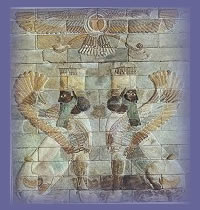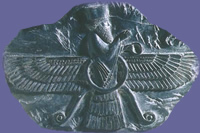(Rembrance day for the prophet Zarathustra)

Winged
disc of Ahura Mazda
(above sphinxes)
Hear
the best with your ears and ponder with a bright mind...
Gatha 3
The
Zoroastrian religion was founded** in ancient Persia
(modern Iran) by the prophet Zarathustra, who taught that there was one
god, Ahura Mazda (lit. ‘wise lord’), symbolised by a
living flame. Contrary to popular belief, members of the faith are not
fire-worshippers; rather, the flame found in the temples is simply a symbol
of the manifested power of God.
The religion has a long—but largely unrecorded—history. However
many scholars believe that the origin of several religious concepts familiar
to Judaism and Christianity—e.g. heaven, hell, resurrection of the
body, the Messiah, final judgment, and the battle of Armageddon—first
appeared in Zoroastrianism.
The
sacred scriptures of the faith are known as the Avesta. It is
said that Alexander the Great destroyed the original manuscript—written,
according to tradition, in gold ink on twelve thousand ox hides—in
330 BCE. However a third of the text survived in the memories of priests.
The oldest portion consists of a collection of songs or hymns, the Gathas,
which are agreed by most to be the work of Zarathustra himself; these
form the core of the Yasna, which is the religion’s primary
liturgy.
**Most likely during the sixth and seventh century BCE

Faravahar or Fravashi
Faravahar
means ‘to choose’,
referring to the choice to lead
a morally upright life. The
image, which represents the soul, is descended from the Egyptian winged
disk, a symbol of divine kingship. It also appears as the representation
of the Assyrian sun god Shamash. The word Fravashi, as used in
Yasna 17, is also applied to ancient representations of Ahura Mazda.
And
I praise, invoke, and glorify the good, heroic,
bountiful Fravashis of the saints...
Yasna
17.18
Although the prophet of Zoroastrianism is familiarly known as Zoroaster, this is actually a Greek transliteration of the name Zarathustra, which means, in ancient Iranian, ‘yellow (zara) camel (ushtra).’ Animals such as camels and horses were essential and even sacred to the pastoral people of Zarathustra’s age, however later Zoroastrians would say that it means ‘golden light’, from zara and ushas, ‘light’ or ‘dawn’, perhaps wishing to give their prophet’s name a more transcendant association.
It seems likely that Zarathustra lived between 628 and 551 BCE. According to Zoroastrian sacred history he was a priest and chanter, his gathas part of the Indo-European tradition of sacred poetry. There seems to be no doubt that he spent many years in meditation in a cave in the mountains. At the end of his retreat Ahura Mazda appeared to him, giving him a message of purity, uprighteousness and truth—which remains to this day as the three basic tenets of the religion: good thoughts, good words and good deeds.
The religious calendar is a matter of some controversy among Zoroastrians. There are currently three main calendars in use: Fasli, Shenshai, and Qadimi. The oldest Zoroastrian calendar was evidently a seasonal one, but it is not clear how it was kept in harmony with the seasons. In later years the prescribed method was to add a month every 120 years, but none of the three modern calendars follow this tradition.
The Fasli (‘seasonal’) calendar is kept in harmony with the seasons by intercalculating one day every four years (patterned after the Gregorian calendar). The calendar used by many Parsee Zoroastrians, including some of the more influential Dasturs (high priests) is the Shenshai. It is based on a religious calendar which was theoretically synchronized with the seasons by intercalculating a month every 120 years, but the intercalculation was not consistently followed. A recent proposal would reform this calendar by bringing it back into harmony through the intercalculation of whole months. In 1746 a group of priests and laymen in Surat adopted the Irani Qadimi (‘ancient’) calendar on the assumption that it represented an older tradition. The Qadimi calendar is one month ahead of the Shenshai.